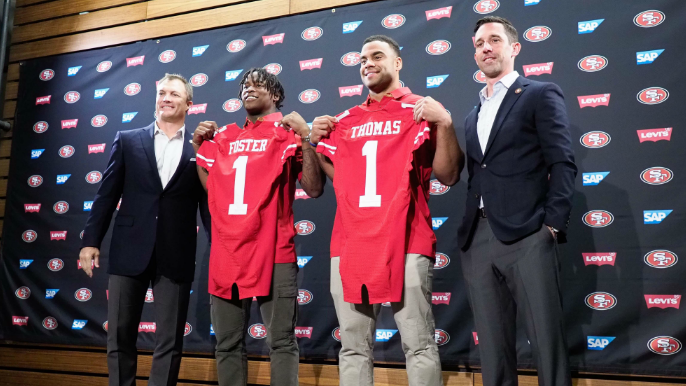
More than four-and-a-half years ago, after a coaching cataclysm of his own creation, 49ers CEO Jed York attempted to lift his franchise out from the deep. York brought in a then-young-faced, clean-shaven Kyle Shanahan, who was abound with optimism. Alongside him was his general manager pick, John Lynch.
As we inch closer to five years of the Shanahan-Lynch era, Shanahan looks exhausted.
This season has been stunning, and is the first in which that braintrust has few answers. In 2017, it was a project. In 2018, Garoppolo got hurt, and the building process was still ongoing. In 2019, it all came together and almost manifested in a Super Bowl. In 2020, there was an unprecedented amount of injuries in a COVID-19 struck season.
In 2021, the 49ers are just bad. It’s not for lack of talent on the roster or coaching staff, but they are second-to-last in turnover differential (-9) with an injury-riddled defense devoid of the stellar pass rush which was supposed to define it. The offense, meanwhile, is perpetually one play away from being one play away and cannot seem to get through a game without beating itself into submission.
If San Francisco loses to the Los Angeles Rams on Monday, they will be 3-6, with an 0-4 division record. It would not mathematically disqualify them from the playoffs, but it would certainly feel like it.
Without next year’s first-round draft pick, the looming question is not just when Trey Lance will start, but when the other rookies the 49ers drafted, especially early on, will get their opportunities.
There is a significant amount of frustration directed at both Shanahan and Lynch, as rookies like Lance, Aaron Banks, Trey Sermon and Ambry Thomas remain on the bench.
With that in mind, here’s a look at what production the 49ers have received from their rookies this year, and since 2017, compared to their division rivals.
A word of warning, just about everything from this point on is numbers and charts.
2021 Rookie Production
Here’s what each team is getting from its 2021 rookies and the context behind that production.
Cardinals
Arizona, thus far, is getting the most production out of its rookies, especially at the top of the draft. Tay Gowan was traded to Philadelphia to acquire Zach Ertz. So far, this is a successful draft; it has early-round, immediate production, and some utility from a late-round (200-plus overall) pick in terms of Gowan’s trade value. Zaven Collins’ shoulder injury and mistakes provide concerns, but he’s had immediate utility this season and playing at a position of need.
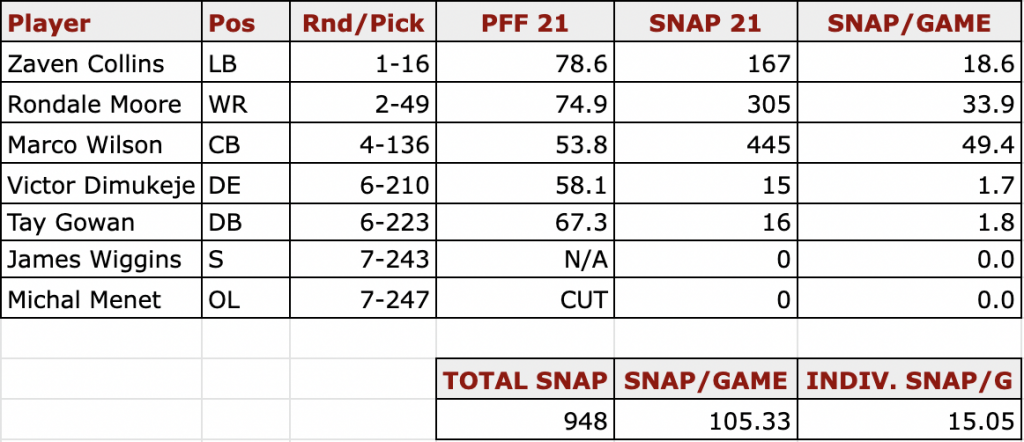
Rams
Los Angeles is not getting much production out of its draft class, with the exceptions of Ernest Jones and Robert Rochell. But it’s also a Super Bowl contender, so its expectations for its rookies should be lower than most. They drafted a wide receiver, who is currently on injured reserve, into a room of Cooper Kupp, Robert Woods and Van Jefferson.
Ernest Jones has provided some utility at a thin linebacker spot, and Rochell has become a starting corner for them. Earnest Brown IV was an obvious miss, while Bobby Brown is understandably struggling to finding time on a deep defensive line.
Overall, it’s a fairly underwhelming draft at this juncture for the Rams, with Atwell’s selection the most concerning and Rochell’s the most encouraging. Again, though, most of these positions were unlikely to start, Jones has now become the starting interior linebacker, and Ben Skowronek is expected to get an opportunity for increased reps on Monday night.
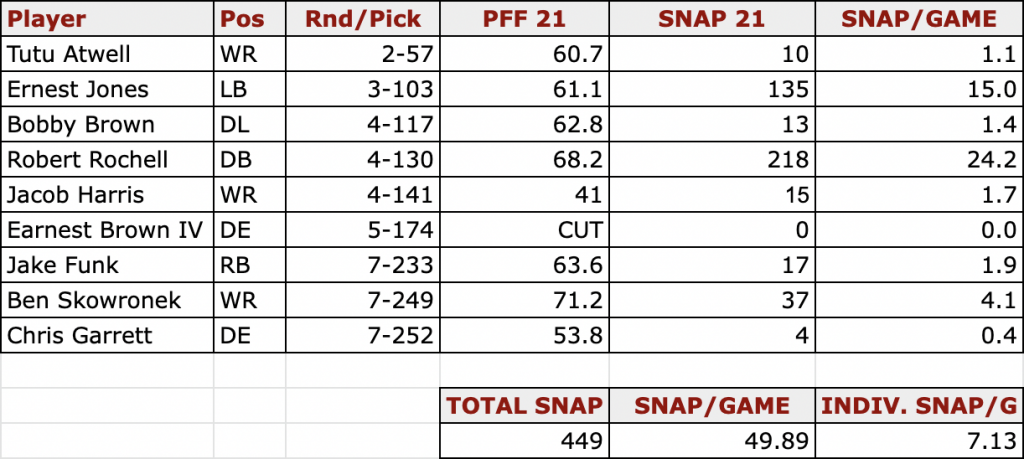
Seahawks
Ahh, the Seahawks’ draft class. After years of flipping picks away for players like Jamal Adams and Jadeveon Clowney, Seattle was left threadbare. It used its first selection on speedster Dee Eskridge, who suffered a brutal concussion, and hasn’t had a real opportunity to play. Its second pick was used on Oklahoma corner Tre Brown, who just started his first game, and has at least been playable. Its last pick was Stone Forsythe, who has yet to play.
This isn’t really much of a draft class to evaluate in the first place, and there’s not really much to evaluate at this point besides Brown. As you’ll see below, Seattle has been horrendous in the draft for the most part, and is largely bailed out by the fact that their quarterback is Russell Wilson. That also explains why the Cardinals, who have been decent in the draft, and the Rams, who have been excellent, are both Super Bowl contenders now that they have elite quarterbacks.

49ers
And the draft class that started this whole thing. There is a lot to question, and not a lot of answers at this juncture. We saw flashes of both Treys, and both were encouraging, but that’s all we’ve seen. We have no idea what Aaron Banks is. Ambry Thomas looked timid when he played and may get a chance on Monday night, but is the least encouraging pick so far.
As the snap counts show, the 49ers have found the most utility, for the most part, at the end of the draft. At this point, Elijah Mitchell has been the best rookie in the NFC West, and it’s not particularly close.
For now, we don’t really have any answers for the most valuable draft pick the 49ers have ever made, and he’ll decide this draft class. Lance isn’t just the third overall pick; he’s also two first-round picks and a third-round pick in the future.
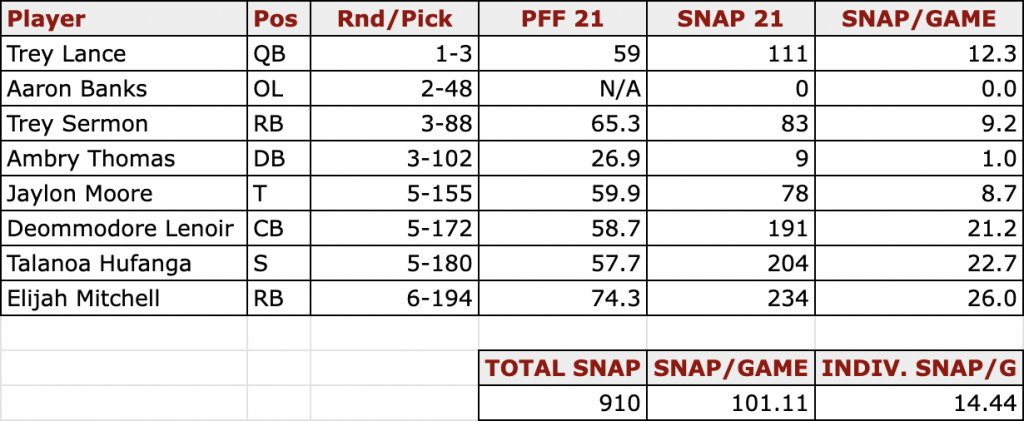
Here’s what the rookie production looks like in total. The Cardinals are just edging out the 49ers in rookie snap counts, though that could shift depending on what Deommodore Lenoir, Ambry Thomas, Jaylon Moore and Trey Sermon do on Monday night.

Draft performance, 2017-20
Given that we can’t really evaluate the rookie draft class from this season, let’s take a wider look at draft class performance since the start of the Shanahan-Lynch era in 2017.
Below is the average snaps per game per draft pick, by team. The blue bar shows the average without this year’s rookies, and the orange bar includes them. This is all before this week’s games, and adjusted to factor in that the Cardinals and Rams entered this week having played nine games to the 49ers’ and Seahawks’ eight.
Since 2017, the 49ers have gotten the most on-field production out of their draft picks. They also lead in cumulative snaps (35,967) by nearly 5,000 over the Rams (29,973), despite having the second-fewest number of draft picks (40) since 2017. The Cardinals have had 37 picks, the Seahawks have had 42 and the Rams have had 45.

Now, for the fun stuff. The major part of this was trying to actually assess how these teams have performed in the draft; not just from a snap count or PFF grade perspective, but incorporating the context of each draft pick and how players have performed relative to their slot.
There are some tricky things to deal with, like the Rams letting go of John Franklin-Myers after a solid rookie season, and him going on to be a very impressive player with the Jets. That selection gets an “OK” grade because I consider cutting talent before it develops is a knock on draft pick assessment and player development.
There are also some players who play a significant amount of snaps despite poor or underwhelming performance. The perfect example of this is Tre Flowers, who continues to play for the Seahawks — and has logged an incredible 2,713 snaps — discernibly, because they have no one else to play at that position. He was still considered a bad pick despite his utility because he’s, well, bad.
So, without further ado, here’s an attempt to grade each NFC West team’s draft performance from 2017 to 2020.
Rating system
In an effort to try and semi-objectively grade that performance, I created a system to give a number grade to each draft pick. The system has flaws, and could certainly be improved, but its purpose is to emphasize the value and significance of early-round picks versus late round picks.
Here’s how it works:
- Whiff (-3 points): A player who was either immediately cut, or who, given their draft position, was an abysmal pick. Solomon Thomas, for example, is in this category. Were he picked later in the first round, he’d just be considered a “bad” pick.
- Bad (-1.5 points, -1 point from 6th round on): A player who performed poorly when on the field, or who was rarely on the field.
- OK (0.25 points): Wide range of players who provide some on-field utility. Might have some good seasons, some bad, but the net is that they are average.
- Good (1.25 points): Performs well when on the field (and mostly on the field), but is not a Pro Bowl caliber player, at least not yet, or not consistently.
- Great (2 points): A Pro Bowl/borderline All-Pro player, but not top-five at their position.
- Diamond (3 points): Top-five player at their position.
Multipliers
This is designed to, again, emphasize the importance of early-round picks over late-round picks.
- Top-5 pick: 2.5x multiplier
- Round 1, Picks 6-15: 2.25x multiplier
- Round 1, Picks 16-32: 2x multiplier
- Round 2-3 through Pick 70: 1.5x multiplier
- Round 3 after Pick 70: 1.25x multiplier
- Rounds 4-5: 1x multiplier
- Round 6: 0.5x multiplier, bad picks worth -1 point from this stage on
- Round 6-7, Pick 200+: 0.25x multiplier – no one selected in this range can be considered a whiff, worst is a “bad” pick
Here’s what the grades look like for each team.

Here’s what that all that looks like, visualized.

Here it is again, separated by team:
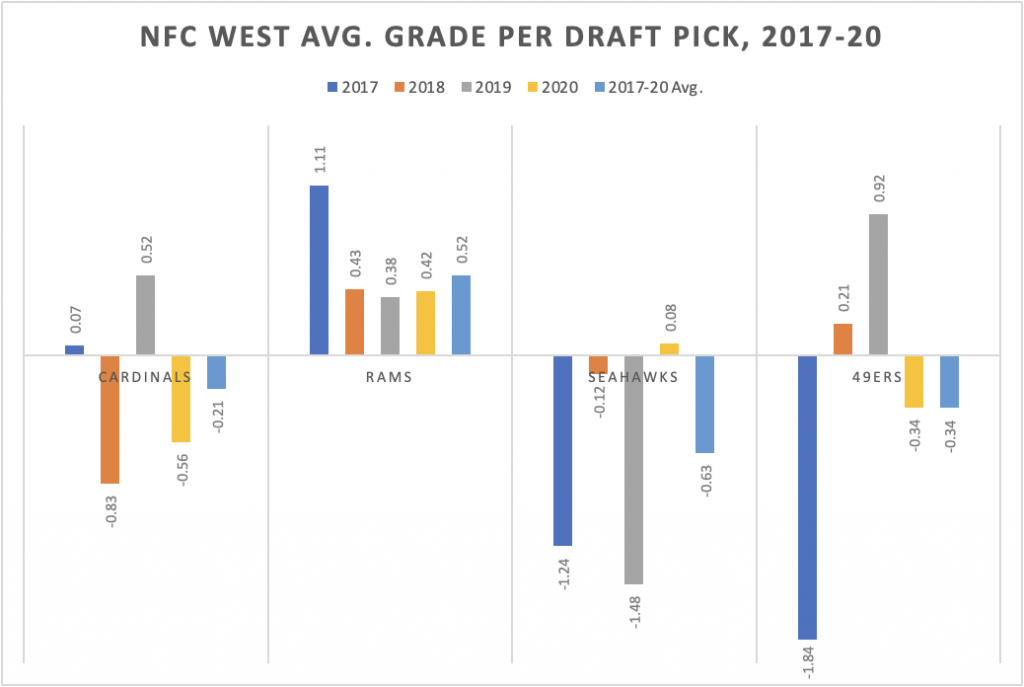
What does all this teach us?
Firstly, more bad picks should be expected than good ones and expecting draft picks to be successful is actually a bad bet, for the most part.
The Rams, clearly, have been the best drafters in the division. Somehow, they’ve managed to fail to have a poor draft in the last four years, though that may change this season. While they haven’t hit on any studs, they continually stack cheap talent, and hit on “good” players, especially in the early rounds, when it matters the most.
The 49ers, though, are the only team to draft two diamond players in George Kittle and Nick Bosa. Kyler Murray is the only other diamond player drafted in the division.
The closest fringe players to diamond are Fred Warner (if he was performing this year like he did last year, he would be in that category), D.K. Metcalf and Budda Baker.
San Francisco’s worst draft, in 2017, was the worst draft class by any team in this era, and that’s despite drafting George Kittle this year. Again, the rating system emphasized the value of early round picks. Kittle went in the fifth, after Solomon Thomas, Reuben Foster, Ahkello Witherspoon, C.J. Beathard and Joe Williams. That’s a heinous stretch of picks.
Overall, it’s unquestionable that the Seahawks are the worst drafters in the division. They’ve had one non-negative draft, last year, thanks largely to a swathe of players who are not outwardly terrible. Their first-round pick, Jordyn Brooks, has not performed well. D.K. Metcalf is their best draft pick in 2017, and the only great selection they’ve made besides seventh-rounder Chris Carson. Their Rashaad Penny selection, with Nick Chubb still behind him, is confounding.
Lastly, here’s how each team’s pick breakdown has gone:
Cardinals
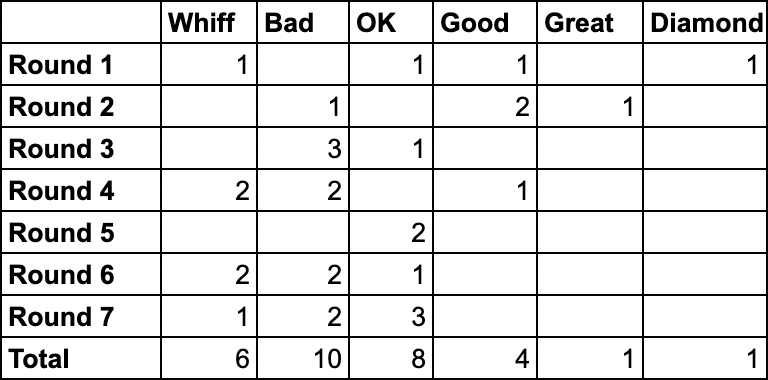
If we consider hit rate as the amount of time a team hits on a good or better player divided by their number of draft picks, the same process, includes whiffs and bad picks to find misses, and strictly whiffs to find whiff rate, Arizona has both a 20 percent hit rate and 20 percent whiff rate, and a 53.3 percent miss rate.
In the first three rounds, they have a 41.7 percent hit rate, a 41.7 percent miss rate and an 8.3 percent whiff rate.
Rams
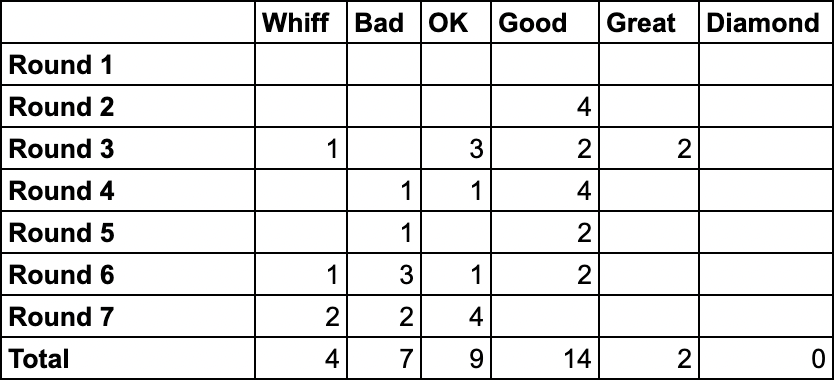
The Rams have a 44.4 percent hit rate a 30.5 percent miss rate and an 11.1 percent whiff rate.
In the first three rounds, they have a 66.7 percent hit rate, a 8.3 percent miss rate and an 8.3 percent whiff rate.
Seahawks
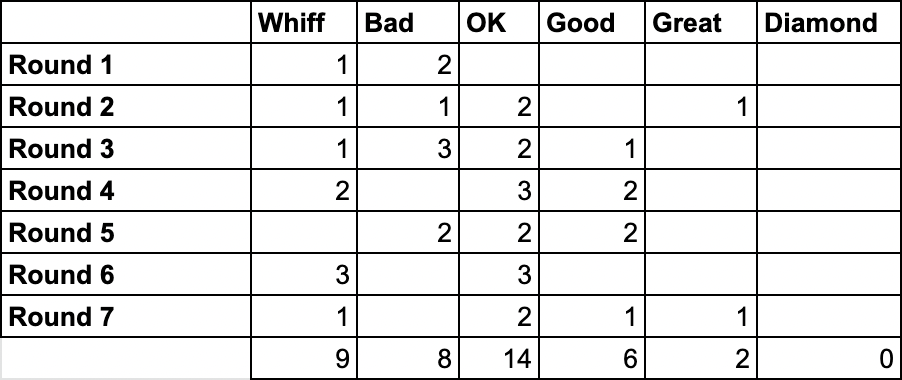
The Seahawks have a 20.5 percent hit rate, a 43.6 percent miss rate and a 23.1 percent whiff rate.
In the first three rounds, they have a 13.3 percent hit rate, a 60 percent miss rate and a 20 percent whiff rate.
49ers
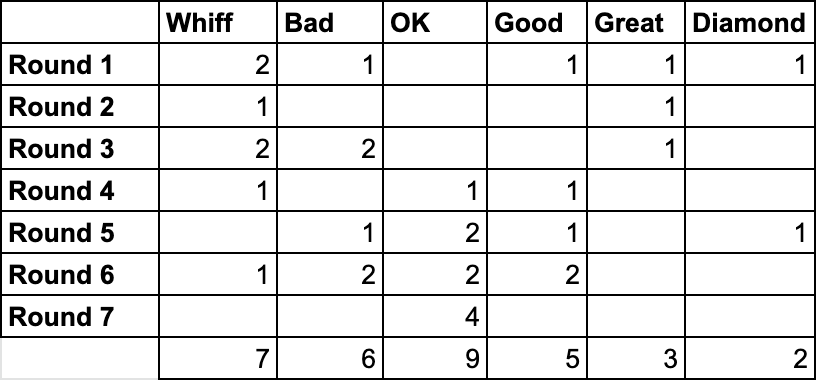
The 49ers have a 31.25 percent hit rate, a 40.6 percent miss rate and a 21.9 percent whiff rate.
In the first three rounds, they have a 38.5 percent hit rate, a 61.5 percent miss rate and an 38.5 percent whiff rate.
Here’s what those hit, miss and whiff rates look stacked up against each other:

And in the first three rounds, when the pick values are at a premium:
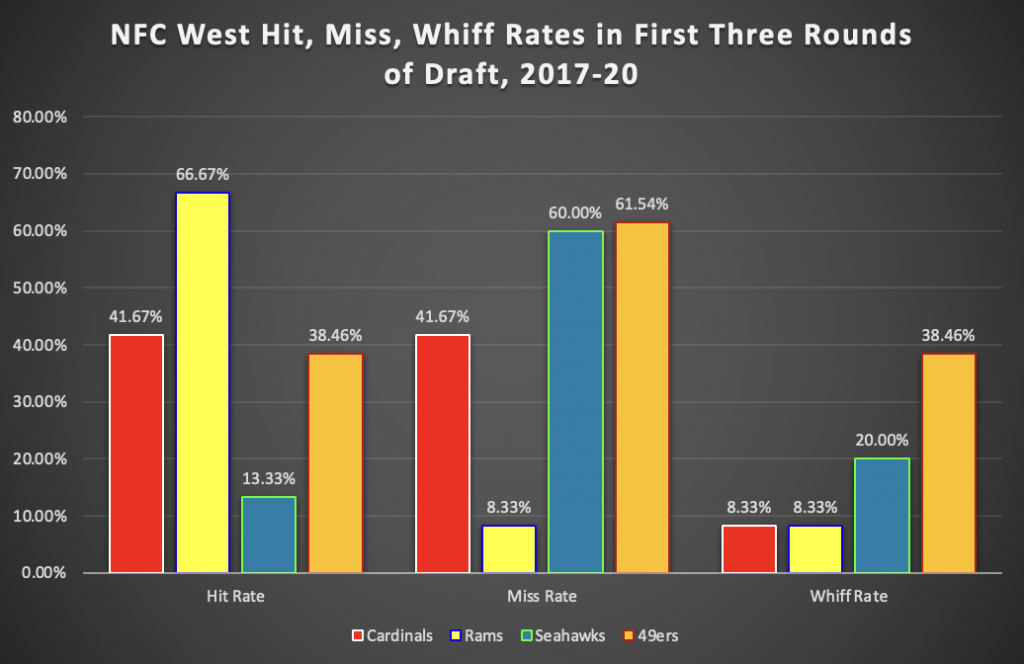
The 49ers are quite literally hit or miss, and have the most whiffs in the first three rounds of the draft.
Considering all these factors over the last half decade, the Rams have been the best drafters, the 49ers second-best, the Cardinals third and clearly, without any question, the Seahawks have been dead last. Luckily for them, they’ve traded away most of their future picks.

